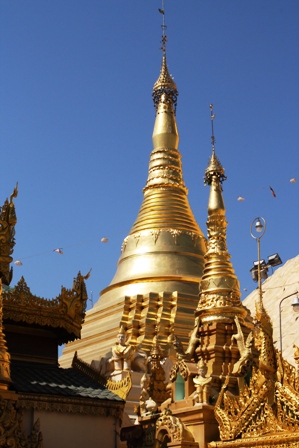
Click the photo above to see an album of photos. To return to our website close the window.
read next episode Cruising Inle Lake
Yangon 3 January 2010
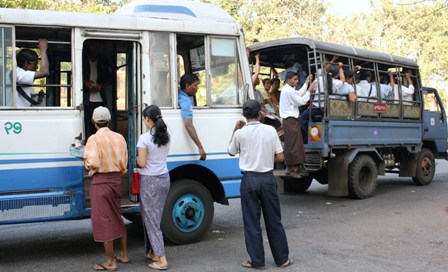 The first thing you notice about the people in Myanmar, even in Yangon, where
we arrived from Bangkok by plane, is that they prefer traditional dress
over western style wear. The vast majority of both men and women wear the longyi
(long-gee). An everyday longyi is a tubular cotton sarong, flower patterned for
the women and plaid for the men. Men tie theirs with a big rosette in front
while women fold the longyi until it is the right circumference and fold the
excess under the waist. It is the perfect outfit for a tropical climate, much
cooler than long pants. The only drawback that I could see is that the longyi
frequently has to be retied. It comes one-size-fits-all so that may have been
the problem for a rather large lady in the Yangon airport. Her longyi suddenly
fell down and she wasn't quite fast enough to prevent me observing that
underclothes are an option.
The first thing you notice about the people in Myanmar, even in Yangon, where
we arrived from Bangkok by plane, is that they prefer traditional dress
over western style wear. The vast majority of both men and women wear the longyi
(long-gee). An everyday longyi is a tubular cotton sarong, flower patterned for
the women and plaid for the men. Men tie theirs with a big rosette in front
while women fold the longyi until it is the right circumference and fold the
excess under the waist. It is the perfect outfit for a tropical climate, much
cooler than long pants. The only drawback that I could see is that the longyi
frequently has to be retied. It comes one-size-fits-all so that may have been
the problem for a rather large lady in the Yangon airport. Her longyi suddenly
fell down and she wasn't quite fast enough to prevent me observing that
underclothes are an option.
The other common observance is the number of monks, and to a lesser extent, the nuns. About 89% of the population is Buddhist and it is required of each male Buddhist that he spend a minimum of three days in a monastery twice in his life; once as a novice monk between the ages of 10 and 20 and again as an adult. A man can stay as long as he wants and then return to secular life. Some men return each year for a short or long period, depending on their other demands. If the man is married, he must obtain the permission of his wife before spending time as a monk. Each morning the monks go forth, with their heads shaved and often barefoot, from their monastery, dressed in a red robe and carrying their begging bowl to be filled with food and cash donations from the faithful.
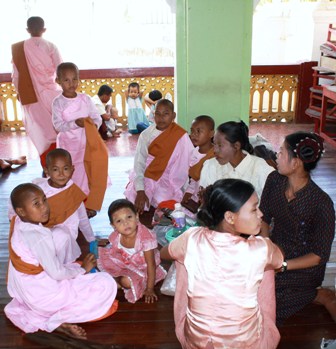
There are other religions in Myanmar. In Yangon we passed by several Christian churches, a few mosques and Hindu temples. Most of the Hindus and Muslims are East Indian people originally brought to Myanmar as labourers. Most live in the larger cities like Yangon.
The mix of people result in a variety of food choices in Yangon.We like to sample try the food in restaurants favoured by the local people and we were not disappointed in Yangon. We had a good Bamar meal, the most common type of food outside Yangon, in a tiny, crowded restaurant on a side street next to a vehicle repair area. We were shown to a high table already occupied by a family of four. We sat on stools and chose our dishes from food sitting in large pots along one side of the room. Our choices of meat and vegetables came with rice, soup, condiments and a dessert of a mixture of nuts and ground beans and cane sugar balls. The mother of the family group at our table spoke very good English. She was a doctor with UNICEF, living in Mandalay. She and her two teen-aged sons were in Yangon to greet their father who had returned from work in Bangkok. He said he recognized us as he had taken the same early morning flight the day before. The woman recommended several places to visit in Mandalay. We will try to take advantage of her suggestions.
Our second restaurant "find", as it is recommended in Lonely Planet, was an Indian Biryani shop. Once again we entered a crowded restaurant and were shown to a comfortable table. The waiters brought us our choice of Biryani, a mild curry. It too came with soup, rice, condiments and this time bananas for dessert. We have not experienced any problems with food and look forward to more new food experiences.
Money creates a problem in Myanmar, especially for independent tourists like ourselves. There are no ATMs and no credit cards. You cannot bring Myanmar currency into the country. US Dollars are the only currency allowed. Lonely Planet had warned us to bring only top quality bills with us. Ray had ordered US Dollars in our local Ottawa bank in denominations of $20 or less. We made two mistakes. We should have specied only mint quality new bills and had a few $100 bills. First of all, noone uses the official bank exchange rate of approx 5 Kyat (chat) to the $. The rate from your guesthouse or from money changers on the street ranges from 9,200 Kyat/$ for denominations under $50 to 10,000 Kyat/$ for $100 bills. On top of that each US$ is rejected if there are any nicks, discolouration, pencil marks or creases. The manager of Mother Land 2, our typical backpacker guesthouse, introduced us to this restriction. Ray had to search through his money supply to profer cash that met her standards. We pay for our accommodation and for some tours with US $ but even those transactions require cash meeting the same standards as exhanges. We still expect to have enough cash to last us the 24 days of our visit but we will have to be careful.
Yangon, known as Rangoon during British rule, is a sprawling city of 6 million people. We stayed in a nice guesthouse on the edge of the city center. We walked everywhere and never felt threatened. In fact, if we consulted a map or seemed unsure of something, we were sure to have someone approach and offer assistance without expecting a tip.
The traffic was another thing. Old cars and trucks abound and the street light are frequently non-funtional. We took the lead from locals and tried to cross the street right beside them. Public transportation is on old buses, small trucks with benches along each side and single person pedi-cabs. Motorcycles have been banned in Yango and we heard that bicycles are also banned. Our eyes and noses told us that air pollution caused by old vehicles without pollution controls was a problem. We could understand the ban motorcycles but not bicycles. Perhaps there have been too many collisions between bicycles and larger vehicles barrelling down the roads. We did have a ride in a public bus across town but we didn't dare brave the truck-bus. They do not leave until every available seat is filled, there is no more room on the floor and people are hanging on to the canopy at the back.
We walked everywhere, braving the uneven and broken pavement and watching out for uncovered holes. You are advised to carry a flashlight after dark as street lights are rare. Most of the buildings are in sore need of paint and general repairs but they are home to numerous families just the same. I have yet to get an explanation for the derelict state of a vast colonial style complex, identified on our map as "Ministers Offices". They appear to be occupied only by squatters.
The central stopping point for all the local buses is across from a traffic circle, the site of the Sule Paya, the landmark golden stupa or pagoda. Across from the bus stop is Mahabandoola Gardens, a pleasant green area centered by the Independence Monument, a white concrete obelisk. As foreigners, we were asked for 500K to enter the gardens so we just looked at it from the street.
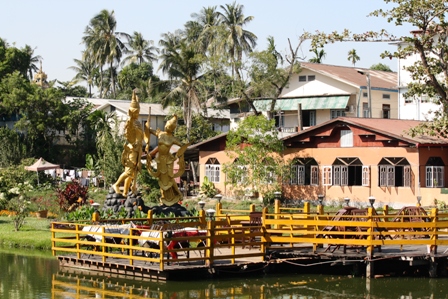
A short distance further west is the biggest market in Yangon, Theingyi Zei. We joined the stream of locals making their way on a narrow corridor between booths piled high with clothing and household goods on either side of us. The market covers several adjacent buildings but one was enough for us. There is supposed to be an area selling traditional herbs and medicines but we failed to find it.
We made our way to a second huge market a few blocks away. Bogyoke Aung San Market also sprawls over several buildings. We wandered through one filled with small seamstress shops with women busily sewing outfits on electric or old treadle machines. At the rear of each shop were displays of their materials, from simple cottons to ornate silks suitable for weddings or special occasions. Across a short walkway to another building was a gemstone and jewelry area. We looked at the gems at several small booths and ended up buying a pair of jade earrings for me to replace ones I lost last year. I have worn them already. There were more areas to explore, more jewlery shops, hand crafted souvenir stalls, vegetable and fruit markets and much more. We could have spent even more time wandering around than we did.
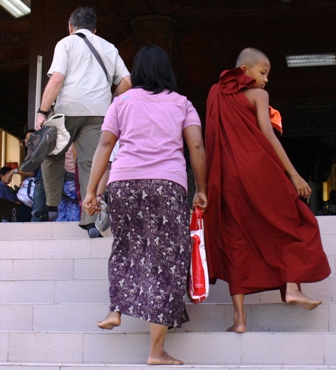
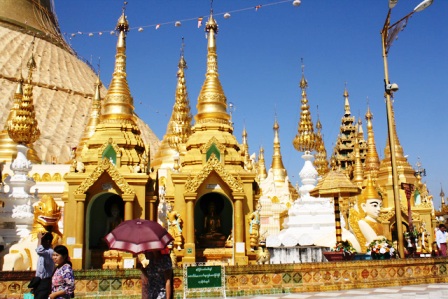 We contracted for a guided visit with Ma Saw Nyo, a pleasant and well
informed lady. At one point I wondered if I would ever get all the information
about Budda's life straight, but it didn't matter. The sheer beauty of the
numerous religious structures on the site. She started by pointing out the
arrangements of smaller stupas surrounding the main stupa. The first level below
the stupa has 4 large stupas marking the four cardinal points, 4 medium ones
marking the corners of the base and 60 small stupas around the perimeter. Men
only are allowed to walk on this level. Below this level are smaller stupas, 20
on each side. The Buddhist week has 8 days with Wednesday morning and Wednesday
afternoon forming the 7th and 8th days. Small shrines for each of the days of
the week are at the corners, identified by their sign. Adherents choose the
shrine of their birth day and pour cups of water, one for each of their years
plus one, or if you wish, nine cups full are enough. My birth day, Sunday, has
the rooster sign while Ray's, Wednesday, is the guinea pig. We declined to make
our water offerings as we would have been there all day filling cups equal to
our many years.
We contracted for a guided visit with Ma Saw Nyo, a pleasant and well
informed lady. At one point I wondered if I would ever get all the information
about Budda's life straight, but it didn't matter. The sheer beauty of the
numerous religious structures on the site. She started by pointing out the
arrangements of smaller stupas surrounding the main stupa. The first level below
the stupa has 4 large stupas marking the four cardinal points, 4 medium ones
marking the corners of the base and 60 small stupas around the perimeter. Men
only are allowed to walk on this level. Below this level are smaller stupas, 20
on each side. The Buddhist week has 8 days with Wednesday morning and Wednesday
afternoon forming the 7th and 8th days. Small shrines for each of the days of
the week are at the corners, identified by their sign. Adherents choose the
shrine of their birth day and pour cups of water, one for each of their years
plus one, or if you wish, nine cups full are enough. My birth day, Sunday, has
the rooster sign while Ray's, Wednesday, is the guinea pig. We declined to make
our water offerings as we would have been there all day filling cups equal to
our many years.
The main stupa was in the process of repair, a regular occurrance. The lower half was shrouded in bamboo cloth under which workers were reapplying the gold leaf. The upper section was still beautiful. Covered in gold plate the stupa is topped with an inverted bowl, a traditional stupa architectural element. The bowl is covered with gold lotus leaves and a banana bud. Next comes a gold flag weather vane and finally a diamond and jewel encrusted orb, tipped with a 76-carat diamond. It is quite a glittering sight.
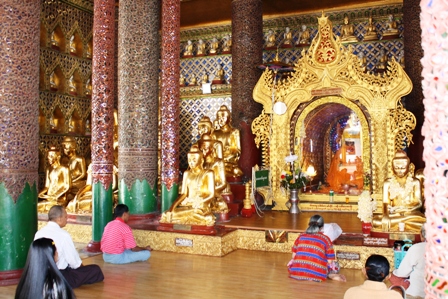
We stopped at a pavillion with murals of Siddharta's (the first Buddha) life on the walls. Several family groups were having lunch as was a group of young nuns, here for the day. In another area was a huge Banyan tree, said to be started from a slip of the original tree under which Siddharta sat to gain enlightenment. If you turn a banyan leaf upside down, its trailing point and heart shape resemble the shape of a stupa.
There were many other stupas and temples we visited but they are too numerous to mention here. You will have to pay a visit yourselves to be as awed as we were.